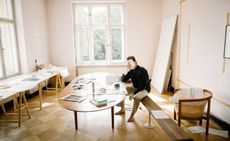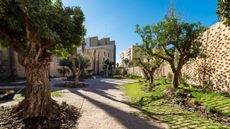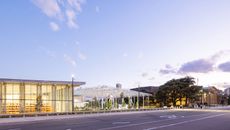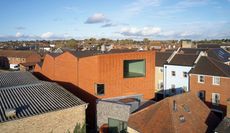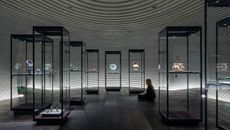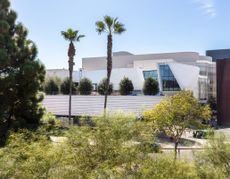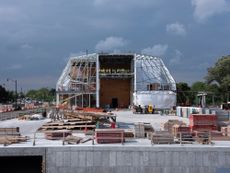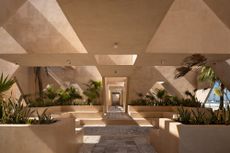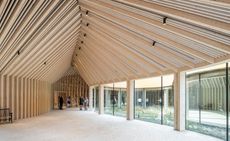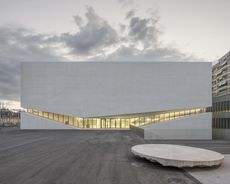Oslo’s Munchmuseet reinvents the museum experience
Oslo’s Munch Museum, designed by Spanish architecture firm Estudio Herreros, opens to the public, offering a twist to the usual museum experience
- (opens in new tab)
- (opens in new tab)
- (opens in new tab)
- Sign up to our newsletter Newsletter
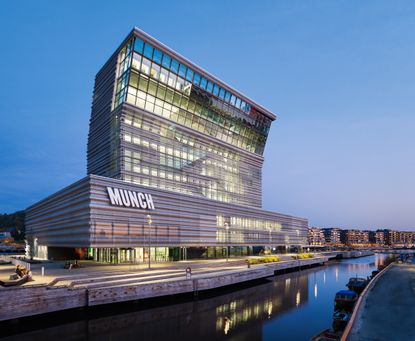
Juan Herreros’ enthusiasm when talking about his new project, Oslo’s Munchmuseet, is palpable. ‘It opened up a conversation about what a museum is,’ he says. ‘They used to be fundamentally places for exhibitions. There was some talk about them being social hubs, places of encounter, but it didn't always translate into the architecture. Now, it is about how to bring all those different conversations and functions together in one building.' The result, the Norwegian capital's latest cultural draw and the new home to the collection of work by Norwegian artist Edvard Munch, the Munch Museum is opening to the public, designed by the Spanish architect's Madrid-based practice, Estudio Herreros.
The launch was delayed due to the pandemic but the project finally opens its doors this week – and it is one of the most highly anticipated museums this side of Christmas in Europe. Yet, Herreros hastens to point out, with ‘about 40 per cent of its surface being dedicated to exhibitions, the displays are not the museum's main role'. While this is certainly a place for tourists and art enthusiasts and specialists, it is far more than that. Inviting in local communities and visitors from afar, schools and scholars, specialists and non-specialists, young and old, the Munch Museum draws on the city around it in more ways than one. ‘It's a vertical museum,' says the architect. ‘And as people go up they discover new layers of the city.'
Munchmuseet: ‘a new model for a museum’

Its distinctive form is part of this approach. Neither a subtle, low-lying volume, nor a big flashy architectural gesture, the Munch Museum sits somewhere in-between, clearly contemporary yet working with its surroundings, both manmade and natural. ‘It's responsive to the changes of the weather in a reactive way,' says Herreros, explaining how the perforated, translucent aluminium façade reflects the climatic conditions around it – from stormy seas to colourful sunsets and grey, cloudy skies. With the right light, it merges into the background – or emerges, prominent and bold.
Its location, in a new, central and lively, mixed-use neighbourhood of Oslo, means that it has a human scale and is surrounded by life and the city – as opposed to dominating within a wider site, as many grand museums often do. ‘It has two roles,' Herreros explains. ‘There is the significance from the water, its pretty postcard aspect, and the urban, human scale from the city's side. That’s why it bows a bit at the top. It is looking at the edge of the coastline and where the city meets the water. The building doesn’t renounce its public presence – it celebrates it. But it is also something you can feel is very close.'

Inside, the space is designed to be extremely flexible. All the rooms are independent, so circulation remains separate, which means that if one room is closed off entirely, the building can still operate without any impact to its flow. It can be divided into sections with various parts acting independently. ‘We were inventing a new model for a museum with this verticality,' says Herreros, ‘and this model of flexibility has been very successful with the pandemic, for example.'
With over 26,700 works in its collection and 11 galleries, there is, of course, plenty of scope for displaying the great artist's work – which includes large-scale murals (such as, The Sun, completed in 1909, which stretches nearly 8m) and several versions of the iconic painting, The Scream. In its 13 storeys, the museum features halls for temporary and permanent exhibitions, community, education and flexible spaces, as well as an outdoor terrace that allows visitors to take in the landscape and the cityscape beyond, and a restaurant located on the 13th floor.

Sustainability was an important part of the design and planning too. The Munchmuseet was created as part of the city’s FutureBuilt programme (an ‘Oslo-wide initiative to halve greenhouse gas emissions across the city’, explain its creators) and recycled materials and energy-saving techniques were used where possible to help lower the scheme’s overall carbon footprint.
As to how, and whether, its subject, Edvard Munch, influenced the museum design? Not as such, is the answer by Herreros, although there are definitely parallels to be drawn between the two. ‘The building is kind of moving, changing, you cannot clearly count its floors and the colour changes [with the] weather,' he says. ‘And for me, with Munch, the climate and atmospheric conditions were a big part of his art. Then, there are parallels around the responsibility of architects. Munch had roots in classical art, in the past, but he was also fighting conservatism, and I felt quite connected in that way, about fighting for progress through your work. And it is beautiful that at the end of his life he gave his work to the city, and he’s part of it.'







INFORMATION
estudioherreros.com (opens in new tab)
Ellie Stathaki is the Architecture Editor at Wallpaper*. She trained as an architect at the Aristotle University of Thessaloniki in Greece and studied architectural history at the Bartlett in London. Now an established journalist, she has been a member of the Wallpaper* team since 2006, visiting buildings across the globe and interviewing leading architects such as Tadao Ando and Rem Koolhaas. Ellie has also taken part in judging panels, moderated events, curated shows and contributed in books, such as The Contemporary House (Thames & Hudson, 2018) and Glenn Sestig Architecture Diary (2020).
-
 Last chance to see: Cyprien Gaillard on chaos, reorder and excavating a Paris in flux
Last chance to see: Cyprien Gaillard on chaos, reorder and excavating a Paris in fluxWe interviewed French artist Cyprien Gaillard ahead of his major two-part show, ‘Humpty \ Dumpty’ at Palais de Tokyo and Lafayette Anticipations (until 8 January 2023). Through abandoned clocks, love locks and asbestos, he dissects the human obsession with structural restoration
By Harriet Lloyd-Smith • Published
-
 Visit Valencia in 2023: what to see, from ceramics studios to coffee shops
Visit Valencia in 2023: what to see, from ceramics studios to coffee shopsVisit Valencia, as Wallpaper* contributor Blaire Dessent whisks us from an artful hotel to the birthplace of a classic Spanish cocktail in a design-led guided tour
By Blaire Dessent • Published
-
 Men’s Fashion Week A/W 2023: what to expect
Men’s Fashion Week A/W 2023: what to expectWe look forward to Men’s Fashion Week A/W 2023 with must-watch moments from Martine Rose, Gucci, Louis Vuitton and more at Pitti Uomo, Milan and Paris
By Jack Moss • Published
-
 Sydney Modern opens its doors and reveals immersive SANAA architecture
Sydney Modern opens its doors and reveals immersive SANAA architectureSANAA’s Sydney Modern opens its doors to the public in Australia
By Ellie Stathaki • Published
-
 Refreshed Gainsborough House in Suffolk gears up for reopening
Refreshed Gainsborough House in Suffolk gears up for reopeningThomas Gainsborough House in Suffolk reopens to a design by architecture studio ZMMA
By Ellie Stathaki • Published
-
 Etruscan Galleries at Fondazione Luigi Rovati by Mario Cucinella just flow
Etruscan Galleries at Fondazione Luigi Rovati by Mario Cucinella just flowIn Milan, the Etruscan Galleries at the Fondazione Luigi Rovati, designed by architect Mario Cucinella, open to the public
By Ellie Stathaki • Last updated
-
 Morphosis unveils flowing Orange County Museum of Art
Morphosis unveils flowing Orange County Museum of ArtExplore the curved shapes and expressive interiors of the Orange County Museum of Art by Morphosis, now open in California
By Ellie Stathaki • Last updated
-
 Buffalo AKG Art Museum by OMA looks to the future
Buffalo AKG Art Museum by OMA looks to the futureThe Buffalo AKG Art Museum (formerly the Albright-Knox Art Gallery) is reborn with a striking OMA-designed extension, site-specific installations, and a new focus on the local community
By Amy Serafin • Last updated
-
 Estudio MMX’s Geology Museum on the Yucatán Peninsula is a big hit
Estudio MMX’s Geology Museum on the Yucatán Peninsula is a big hitEstudio MMX’s new crater-inspired Geology Museum on the Yucatán Peninsula is sure to be a big hit
By Ellie Stathaki • Last updated
-
 BIG’s Refugee Museum of Denmark addresses ‘one of the world’s greatest challenges’
BIG’s Refugee Museum of Denmark addresses ‘one of the world’s greatest challenges’BIG has converted and extended buildings at a Second World War Danish refugee camp to create the new Refugee Museum of Denmark
By Hannah Silver • Last updated
-
 Twin cultural destination Photo Elysée and Mudac completed in Lausanne
Twin cultural destination Photo Elysée and Mudac completed in LausanneArchitecture studio Aires Mateus completes its building to house Photo Elysée and Mudac in Lausanne, Switzerland
By Ellie Stathaki • Last updated
